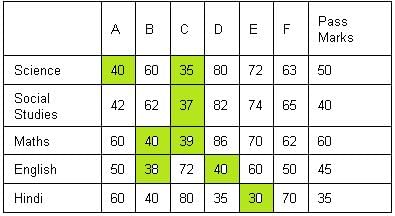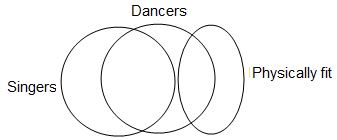APSET Paper 1 Mock Test - 2 - AP TET MCQ
30 Questions MCQ Test APSET Mock Test Series 2026 - APSET Paper 1 Mock Test - 2
Direction: Following table shows the percentage distribution of votes amongst five candidates A, B, C, D and E and total votes cast (in hundred) during the year 2013 to 2018 of collage presidential election. Study the data carefully and answer the questions based on it.
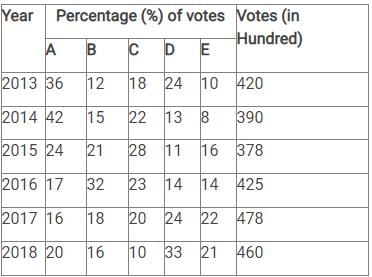
Q. If, out of the total number of voters in 2016 who fevered D, only 40 % could successfully cast their votes and remaining was unsuccessful. Find the number of voters who appeared to cast their votes in favour of D:

Which of the following statements are true?
1. Some arguments, while not completely valid are almost valid.
2. A sound argument may be invalid.
3. A cogent argument may have a probably false conclusion.
4. A statement may be true or false.
Choose from the alternatives given below.
(A) 1 and 2
(B) 1, 3 and 4
(C) 2 and 4
(D) 3 and 4
1. Some arguments, while not completely valid are almost valid.
2. A sound argument may be invalid.
3. A cogent argument may have a probably false conclusion.
4. A statement may be true or false.
Choose from the alternatives given below.
(A) 1 and 2
(B) 1, 3 and 4
(C) 2 and 4
(D) 3 and 4
Direction: Read the given passage and answer the questions that follow.
Early feminist theory had emphasised the commonalities of women's oppression, neglecting profound differences between women in terms of class, age, religion, race and nation. As its exclusionary nature became evident, the collective 'we' of feminism was called into question. The inadequacies of feminist theorising that conflated the condition of white, middle class women with the condition of all women were highlighted in North America by black and Latin feminists, and in Britain by black and Asian feminists. Such critiques evoked the concepts of 'inter‐locking identities' and inter‐locking oppressions'. Related and more radical analyses came from feminist scholars in the Third world, where quite different agendas were called for. These critiques heightened the irrelevance of western feminism's analytical frameworks to the lives of most women around the world and attempted to reposition feminist debate within broader social, economic and cultural contexts of analysis advocated by scholars such as Janus. Such critiques spoke from a post‐colonial position, in which the self‐assumed authority of western feminists to speak about or indeed for others was disputed and decentered. Influential accounts of the tendencies of masculinist imperialist ideological formation to construct a 'monolithic Third world' woman', discursively constituted as the universal victim of Third world patriarchy, challenged feminists to "unlearn" their privilege and to deconstruct their own authority as intellectuals. These positions appeared to question the legitimacy of outside intervention of any kind, whether intellectual or political. Although subsequently attempted by the Third world scholars anxious to move beyond standpoints that threatened to mark all feminist politics as either inauthentic or unnecessary, they were enduringly influential in highlighting the questions identity and authority in feminist studies.
Q. The early feminist theory ignored among women, the issue of:
The communication which happens outside the realm of interpersonal communication is called:
Directions: Answer the given question based on the following data.
Total number of students in the university = 2160
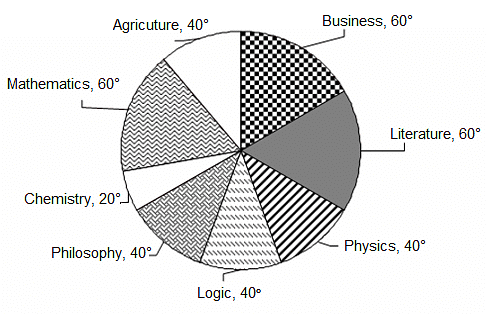
Q. Total number of students of Philosophy and Logic is more than the total number of students of Physics and Chemistry by
Which of the following stages involves the acquisition of knowledge of 'Shrutis' by listening to Vedic Education?
(A) Nididhyasana
(B) logic
(C) Shravan
(D) Contemplation
Match List - I with List-II and select the correct answer from the code given below:
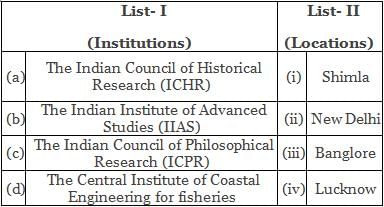
Under the Air Quality Index in India, which of the following pollutants is not included?
Directions: Answer the given question based on the following table.
Marks obtained by 6 candidates A, B, C, D, E and F:
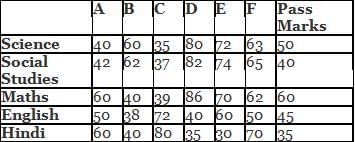
Q. Which of the following candidates did not fail in any of the subjects?
Given below are two statements:
Statement I: Nitrification results in an increase in effluent ammonia toxicity
Statement II: Denitrification reduces nitrate to nitrogen gas using bacteria
In light of the above statements, choose the most appropriate answer from the options given below:
Directions: Read the following passage and answer the given questions:
Recently, India witnessed a severe power shortage due to high demand and the non-availability of adequate coal supply. An energy deficit of more than 100 million units has been recorded during the month of April 2022. Rajasthan, Haryana, Punjab, UP, Bihar, and Madhya Pradesh were the most affected states. India is the second largest country in terms of population, and the usage of electricity is increasing day by day. In today's India, electricity has reached even the remotest areas, and people are reaping its benefits. Electricity is critical to the overall development of society and the country, including technological development. However, technological advances require more electricity. The power requirement of many industries, such as railroads, agriculture, and domestic use, is increasing day by day.
The advancement of technology and the resurgence of economic activity following the COVID-19 disruptions increased the demand for power. In April 2022, the average daily energy requirement increased to 4,512 million units, as opposed to 3,941 million units in April 2021, registering a growth of 14.5%. The use of electricity has increased in many industries, including railways, agriculture, and households. India's thermal power plants are also running well below their capacity, which could have managed this demand increase by increasing thermal generation. To address the problem of the power crisis in India, there is a need to change our planning and policies from ones that mainly manage shortages to ones that are flexible. Policies should be formulated with a focus on long-term structural solutions that address delivery, financial viability, and a robust mechanism for resource planning. The focus should be on ensuring that power plants operate efficiently. To address power shortages, a strategic approach to the low-cost energy transition, such as renewable energy and opportunities for diversification in the energy mix, is critical. For long-term power security, greater attention should be paid to accelerating generation from renewable energy sources.
Q. Choose the most appropriate option that describes the meaning of the term ‘renewable energy’ as used in the passage.
Directions: Read the following passage carefully and answer the given question.
The catalytic fact of the twentieth century is uncontrollable development, consumerist society, political materialism, and spiritual devaluation. This inordinate development has led to the transcendental ‘second reality’ of sacred perception that biologically transcendence is a part of human life. As the century closes, it dawns with imperative vigour that the ‘first reality’ of enlightened rationalism and the ‘second reality’ of the beyond have to be harmonised in a worthy state of man. The defacto values describe what we are, they portray the ‘is’ of our ethic, they are est values (Latin est means is). The ideal values tell us what we ought to be, they are esto values (Latin esto ‘ought to be’). Both have to be in the ebb and flow of consciousness. The ever new science and technology and the ever-perennial faith are two modes of one certainty, that is the wholeness of man, his courage to be, his share in Being.
The materialistic foundations of science have crumbled down. Science itself has proved that matter is energy, processes are as valid as facts, and affirmed the non-materiality of the universe. The encounter of the ‘two cultures’, the scientific and the humane, will restore the normal vision, and will be the bedrock of a ‘science of understanding’ in the new century. It will give new meaning to the ancient perception that quantity (measure) and quality (value) coexist at the root of nature. Human endeavours cannot afford to be humanistically irresponsible.
Q. The 'de facto' values in the passage mean
What among the following is the major factor of biodiversity change?
‘Fly ash’ produced in thermal power plants is an eco-friendly resource for use in:
1) agriculture as micro-nutrient
2) wasteland development
3) dam and water holding structures
4) brick industry
Choose the correct answer from the code given below:
Directions: Read the following passage carefully and answer the question.
The popular view of towns and cities in developing countries and of urbanisation process is that despite the benefits and comforts it brings, the emergence of such cities connotes environmental degradation, generation of slums and squatters, urban poverty, unemployment, crimes, lawlessness, traffic chaos etc. But what is the reality? Given the unprecedented increase in urban population over the last 50 years from 300 million in 1950 to 2 billion in 2000 in developing countries, the wonder really is how well the world has coped, and not how badly.
In general, the urban quality of life has improved in terms of availability of water and sanitation, power, health and education, communication and transport. By way of illustration, a large number of urban residents have been provided with improved water in urban areas in Asia’s largest countries such as China, India, Indonesia and Philippines. Despite that, the access to improved water in terms of percentage of total urban population seems to have declined during the last decade of 20th century, though in absolute numbers, millions of additional urbanites have been provided improved services. These countries have made significant progress in the provision of sanitation services too, together, providing for an additional population of more than 293 million citizens within a decade (1990-2000). These improvements must be viewed against the backdrop of rapidly increasing urban population, fiscal crunch and strained human resources and efficient and quality-oriented public management.
Q. Which of the following is/are not considered the indicator(s) of urban quality of life?
Direction: The following consists of a question and two statements numbered I and II given below it. You have to decide whether the data provided in the statements are sufficient to answer the question.
What is Rohit's rank in the class?
Statement I. Rohit's rank is 24 less than Nandani's rank.
Statement II. Archana's rank is 38 more than Rohit's rank. Nandani's rank is 10 less than Archana's rank.
______ is committing to the factual information to memory.
Directions: Read the following passage carefully and answer the question.
It should be remembered that the nationalist movement in India, like all nationalist movements, was essentially a bourgeois movement. It represented the natural historical stage of development, and to consider it or to criticise it as a working-class movement is wrong. Gandhi represented that movement and the Indian masses in relation to that movement to a supreme degree, and he became the voice of Indian people to that extent. The main contribution of Gandhi to India and the Indian masses has been through the powerful movements which he launched through the National Congress. Through nation-wide action he sought to mould the millions, and largely succeeded in doing so, and changing them from a demoralised, timid and hopeless mass, bullied and crushed by every dominant interest, and incapable of resistance, into a people with self-respect and self-reliance, resisting tyranny, and capable of united action and sacrifice for a larger cause.
Gandhi made people think of political and economic issues and every village and every bazaar hummed with argument and debate on the new ideas and hopes that filled the people. That was an amazing psychological change. The time was ripe for it, of course, and circumstances and world conditions worked for this change. But a great leader is necessary to take advantage of circumstances and conditions. Gandhi was that leader, and he released many of the bonds that imprisoned and disabled our minds, and none of us who experienced it can ever forget that great feeling of release and exhilaration that came over the Indian people.
Gandhi has played a revolutionary role in India of the greatest importance because he knew how to make the most of the objective conditions and could reach the heart of the masses, while groups with a more advanced ideology functioned largely in the air because they did not fit in with those conditions and could therefore not evoke any substantial response from the masses.
It is perfectly true that Gandhi, functioning in the nationalist plane, does not think in terms of the conflict of classes, and tries to compose their differences. But the action he has indulged and taught the people has inevitably raised mass consciousness tremendously and made social issues vital. Gandhi and the Congress must be judged by the policies they pursue and the action they indulge in. But behind this, personality counts and colours those policies and activities. In the case of very exceptional person like Gandhi, the question of personality becomes especially important in order to understand and appraise him. To us he has represented the spirit and honour of India, the yearning of her sorrowing millions to be rid of their innumerable burdens, and an insult to him by the British Government or others has been an insult to India and her people.
Q. Gandhi played a revolutionary role in India because he could
In a certain code, CLOCK is written as KCOLC. How would STEPS be written in that code?
Direction: Study the following table and answer the question asked.
The data of total number of people in different cities of a country and percentage of females is given in the table.

Q. The total number of people in City D is approximately what percent of the total number of people in City B?
Under GATS, higher education policies are to be framed by which of the following Departments?
Given below are two statements:
Statement I: Buddhism accepts Upamana as an independent source of valid knowledge.
Statement II: In Upamana, knowledge of an object is determined by perception and testimony.
In the light of the above statements choose the correct answer from the options given below:
If you get an opportunity to teach a visually challenged student along with normal students, what type of treatment would you like to give him in the class?
McGrath earned a profit of Rs. 300 by selling 100 kg of a mixture of A and B types of rice at a total price of Rs. 1,100. What was the proportion of A and B types of rice in the mixture if the cost prices of A and B are Rs. 10 and Rs. 5 per kg, respectively?
Given below are two statements, one labelled as Assertion (A) and the other as Reason(R). Read and examine the statements carefully and choose the correct option.
Assertion (A): Some carbonaceous aerosols may be carcinogenic.
Reason (R): They may contain polycyclic aromatic hydrocarbons (PAHs).
Directions: Read the following passage carefully and answer the following question.
All historians are interpreters of text if they be private letters, Government records or parish birthlists or whatever. For most kinds of historians, these are only the necessary means to understanding something other than the texts themselves, such as a political action or a historical trend, whereas for the intellectual historian, a full understanding of his chosen texts is itself the aim of his enquiries. Of course, the intellectual history is particularly prone to draw on the focus of other disciplines that are habitually interpreting texts for purposes of their own, probing the reasoning that ostensibly connects premises and conclusions. Furthermore, the boundaries with adjacent subdisciplines are shifting and indistinct, the history of art and science both claim a certain autonomy, partly just because they require specialised technical skills. Both can also be seen as part of a wider intellectual history, as is evident when one considers. For example, the common stock of knowledge about cosmological beliefs or moral ideals of a period.
Like all historians, the intellectual historian is a consumer rather than a producer of ‘methods’. His distinctiveness lies in which aspect of the past he is trying to illuminate, not in having exclusive possession of either a corpus of evidence or a body of techniques. That being said, it does seem that the label ‘intellectual history’ attracts a disproportionate share of misunderstanding.
It is alleged that intellectual history is the history of something that never really mattered. The long dominance of the historical profession by political historians bred a kind of philistinism, an unspoken belief that power and its exercise was ‘what mattered’. The prejudice was reinforced by the assertion that political action was never really the outcome of principles or ideas that were ‘more flapdoodle’. The legacy of this precept is still discernible in the tendency to require ideas to have ‘licensed’ the political class before they can be deemed worthy of intellectual attention, as if there were some reasons why the history of art or science, of philosophy or literature, were somehow of interest and significance than the history of Parties or Parliaments. Perhaps in recent years, the mirror-image of this philistinism has been more common in the claim that ideas of any one systematic expression or sophistication do not matter, as if they were only held by a minority.
Q. What is philistinism?
Directions: Choose the correct alternative that will complete the series below.
DEB, IJG, NOL, ?, XYV
Given below are two premises (A and B). Four conclusions are drawn from them. Select the code that states validly drawn conclusion(s) (taking the premises individually or jointly).
Premises:
A. Some dancers are physically fit.
B. Some singers are dancers.
Conclusions:
1. Some singers are physically fit.
2. Some dancers are singers.
3. Some physically fit persons are dancers.
4. Some physically fit persons are singers.
|
60 tests
|





 = 120
= 120